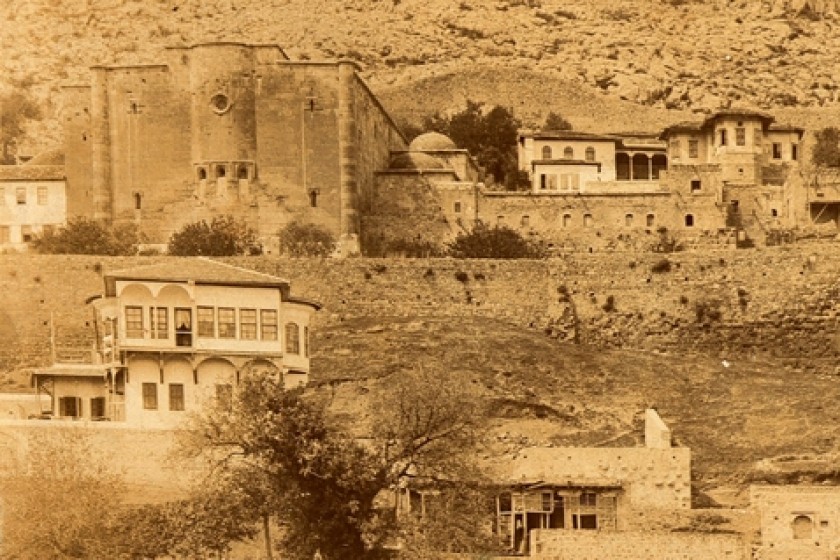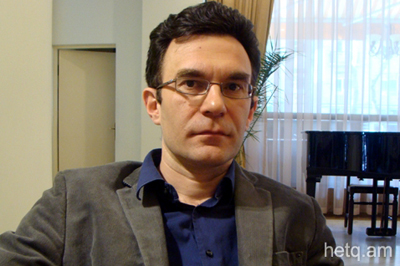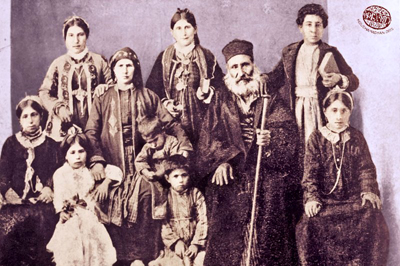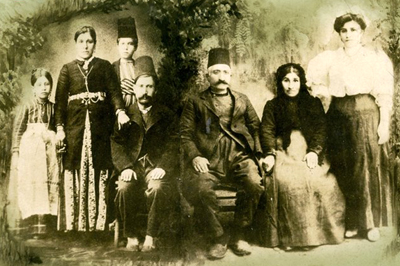
Houshamadyan: Lebanese-Armenian is on a Mission to Reconstruct the Lost World of Ottoman Armenian Town and Village Life
It was only by accident that Lebanese-Armenian Vahe Tachjian found out that his grandfather’s house in Sis was still standing
Years ago an archaeologist friend of Tachjian, a Lebanese-Armenian historian now residing in Germany, traveled to Sis on a work project. Like many other foreign visitors, he stayed at Yaverin Konağı (Yaver House), the town’s only boutique hotel and restaurant.
Later the man showed Tachjian pictures of the hotel and said, “Look at this beautiful hotel. In the past it was the home of some Armenian.”
At once, Tachjian recognized the hotel – it was the mansion of his grandfather, Krikor Mjrkian. It had been converted into a hotel after all these years. Tachjian said that his family has always kept a photo of the mansion in their archives. In addition, Mjrkian’s mansion appears in many of the photos of old Sis. People taking pictures of the Sis Catholicosate were bound to capture the mansion as well since it was located in front of the religious center.
Today, visitors staying at the hotel will see a photo of the old mansion and read the name of the former owner of the building. But the accompanying short history is distorted. It reads the Mjrkian bequeathed the mansion to his eldest son Khatchik and that he later sold it to a Turk in 1923.
The reality is quite different. Mjrkian had good connections with the members of the local Ittihadist party and was able to make it through the Genocide alive, within the confines of his house. But in 1918, two Turkish members of that same party murdered Mjrkian in front of his house.
“The French had arrived in Sis by 1919," Tachjian said. "Until 1920, there was still an Armenian presence in Sis, but they all left that year, including my family. What’s more interesting is that when I was working in the French archives (all the archives of French Cilicia are to be found in Nantes), I found the court file of Mjrkian’s murderers. The French had captured the two killers and wanted to try them in court. Later, due to political reasons, they deemed it preferable to let them go.”
Khatchik and the rest of Mjrkian’s children were born in that mansion. They all survived the Genocide and immigrated to Cyprus and later to Beirut.
“In the 1960s, Khatchik, my grandfather, got into contact with his old Turkish neighbors who were living in Sis," Tachjian said. "He visited Sis just so he could see the house. He took some photos and returned. A few years later he passed away. I don’t know if his death was caused by the emotions he experienced there. He saw his house for the last time and died."
When the section on Sis is ready on the Houshamadyan website, it will probably include the story of Mjrkian and his mansion
The Armenians of the Ottoman Empire Left Over 300 Memoirs
 |
| Vahe Tachjian |
Tachjian is the director and chief editor of the Houshamadyan project. The Houshamadyan non-profit organization was founded in 2010 in Berlin and had 20 members. Houshamadyan is a project designed to “reconstruct Ottoman Armenian town and village life" and aims to depict how Armenians lived before the 1915 Genocide. Images of that life are reconstructed through the memoirs bequeathed by Armenians who lived in the Ottoman Empire and had either survived the Genocide or had emigrated earlier.
The primary sources for Houshamadyan are the more than 300 memoirs in which the survivors wrote, starting in the 1920s, about the towns and villages in which they once lived. There are also articles written in the Constantinople, Tiflis and Baku Armenian press and books printed in Constantinople and Tiflis on the same subject matter.
By studying and collating this material, Houshamadyan is able to present an overall picture of life for Armenians in the Ottoman Empire, whether related to society, history, music, trade, holidays, religious customs, cuisine, literature and so forth.
Houshamadyan strives to use only Armenian language sources. It believes the accepted practice in Ottoman studies of using only Ottoman, French and English sources to depict the history of Armenians as a big mistake. In addition, the daily life of Armenians is only lightly touched upon in Ottoman studies.
The families of Genocide survivors often donate old photos, documents and other items of tangible culture value to Houshamadyan to be displayed on the website. Tachjian said that such items bear the entire memory bank of a given family, but that a family might not comprehend a given item’s importance.
“Last year we launched our first tour," Tachjian said. "We went to Beirut and, in conjunction with Haigazian University, we organized a meeting at a school in the Armenian populated neighborhood of Bourj Hamoud. We announced that the Houshamadyan group had come from Berlin and requested old photos, documents, items or anything else that their grandparents or other relatives had brought from the Ottoman Empire. We would photograph it on the spot and return it. Heeding our call, many Lebanese-Armenians directly donated a bunch of items to us. We now keep them in Berlin."
On March 27, Houshamadyan opened it first exhibition at the Greens Party cultural center in Berlin. It will last for two weeks and will display photos and a number of other items.
Houshamadyan studies the history of not only Western Armenia but all regions of the Ottoman Empire (for example the western districts of Konya and Izmir and the Arab provinces of Baghdad, Aleppo and Jerusalem) where Armenians lived. A large number of memoirs were written about Armenians not only in Western Armenia but in the above-mentioned regions as well. Tachjian said this is why the Houshamadyan website uses the terms Ottoman Armenians and not Western Armenians.
During the Genocide, Armenians living in the mountains took up arms while those in the towns tried to reason with the Turks
 |
| Kesirig (Kesrig) village’s priest Rev Hagop Der-Hagopian and his family (Source: Vahé Haig.) This photo is from houshamadyan.org |
When sifting through the materials collected by Houshamadyan, Tachjian always learns something new and interesting. For example, in Western Armenian villages the houses were one story. If not, they had no window or just a small one on top. What’s new is that after 1908, those one story homes became two story and with a window or two.
“Having a window signified that the outside would be looking in on you," Tachjian said. "Before, a stranger couldn’t look inside. That’s to say a neighboring Kurd or Turk would start looking inside. For them, that psychological change happened after 1908."
A short time later, in 1909, the massacre of Adana Armenians would alter that hope for a new life. After 1909, those Armenians who had left for the United States and had returned with their families to Western Armenia were thoroughly disillusioned and once again left for America or Egypt.
As to whether the pre-Genocide social milieu and daily life of Armenians in the Ottoman Empire revealed any indications that years later these same Armenians would be subject to Genocide, Tachjian said that Armenians either didn’t wish to see the coming tsunami that would destroy them or that they couldn’t understand where it was headed. He argues that this is because the Armenians comprised the weakest element in an empire that started down the road of committing genocide.
He also notes that it’s difficult to leave your hearth and home in times of comparative peace; when no practical steps are being taken to destroy you. The first objective of Armenians was to remain in the Ottoman Empire and to live safely and well. Armenians were puzzled as to why the Ottoman authorities weren’t safeguarding their lives and property from marauding Kurdish beys and were seeking assistance from those same authorities and Armenian institutions in its service. When they found no solution from those quarters it was only then that Armenians slowly started to think of other solutions. Khrimian Hayrik presented one of those solutions, but you can’t pick up an “iron ladle” and wield it in the course of one day.
When I asked if his study of Houshamadyan materials revealed any differences in lifestyle between those Armenian communities that organized self-defense efforts and those that didn’t, Tachjian responded that those residing in mountain enclaves, semi-autonomous and with little contact with the outside world (Mousa Ler, Zeytoun, Shadakh), took up arms and resisted when they were ordered to pack up and leave. Armenians living in the towns tried to reason with the Turks and convince themselves that this was merely a temporary resettlement. They believed the statements of community leaders and institutions who, also under the influence of the authorities, told Armenians that they would all be returning.
Turkey’s Embassy shows an interest in Houshamadyan, but not the government of Armenia
 |
|
The Gosdanian family from the town of Harput/Kharpert. (Isabel Calusdian Goshgarian collection.) Photo: houshamadyan.org |
Tachjian said the history of the culture and lifestyle of Western Armenia is forgotten, both in the Republic of Armenia and the diaspora. Today’s Armenians might be able to say where their grandparents came from, but as to how they lived is a different matter. Fifty years ago there were still people who knew. That generation has since passed and a new, reconstructed history has come to the fore. In the new Armenian historiography, there is no room for local histories.
The Houshamadyan director believes that not enough work is being done in Armenia to research the history of Western Armenia. True, the Genocide is studied, but research into the life of Armenians before 1915 is rare. There is a great deal of material regarding the Western Armenian legacy stored away in the archives in Armenia, but it must all be examined, organized and published.
In Berlin at the end of this year, Houshamadyan will publish the first volume of an academic research study entitled “Ottoman Armenians.” The volume will include 10 academic articles and photos regarding the social and cultural life of Armenians. Houshamadyan also plans to organize lectures, conferences and exhibitions in the future.
Tachjian laments the fact that no representative of the Armenian government, even the Ministry of the Diaspora or the Ministry of Foreign Affairs, has yet to express an interest in the work carried out by Houshamadyan.
In comparison, Turkey’s Embassy in Germany had contacted Houshamadyan, asking about its activities and members. The embassy even advised the organization to refrain from using the term "genocide."
Most visitors to the Houshamadyan website are from the United States, Armenia and Turkey, especially from the interior provinces.
Houshamadyan operates on the largesse of individual donors. In addition to a small permanent staff, the organization has a network of volunteers ready to help.
Funding and employing an adequate staff remain major problems. But Tachjian said that despite the obstacles the work being carried out is a reward in itself. After all, they are reconstructing an entire world.
1st photo: Sis. Krikor Mjrkian's house is on the left, located just in front of Sis Catholicosate. Courtesy of Vahe Tachjian.
 Videos
Videos Photos
Photos
Comments (6)
Write a comment